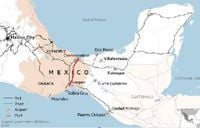As the final week of August 2025 draws to a close, Mexico stands at a crossroads—one marked by robust economic realignment, ambitious infrastructure projects, and a political climate charged with both opportunity and tension. Under President Claudia Sheinbaum’s leadership, the country is navigating a delicate balance: attracting record foreign investment and modernizing key industries, all while asserting its sovereignty in the face of mounting security concerns and deep-rooted social inequalities.
In the business sector, seismic shifts have occurred. GE Appliances’ headline-grabbing decision to pull $3 billion in investment from Mexico and relocate operations to the United States sent ripples through the manufacturing landscape. CEO Kevin Nolan cited evolving trade dynamics, rising labor costs, and tariffs imposed by U.S. President Donald Trump as major factors behind the move. Yet, even as some global players exit, others are digging in. L’Oréal announced an $80 million expansion of its Mexican operations, and OData inaugurated a state-of-the-art data center in San Miguel de Allende, underscoring the country’s growing significance in digital infrastructure. According to Mexico News Daily, foreign investment for the first half of 2025 has soared to three times last year’s levels—a testament to Mexico’s enduring appeal to international capital despite shifting winds.
The auto industry, long a linchpin of Mexico’s export economy, is experiencing its own transformation. In June, Canada imported more vehicles from Mexico than from the United States for the first time, signaling a realignment of North American trade flows. While analysts caution that this could be a fleeting milestone as markets adjust, the achievement demonstrates Mexico’s deep integration into continental supply chains. Meanwhile, the domestic financial sector continues to thrive. Brazilian fintech giant Nu reported a remarkable 52% growth in its Mexican credit card accounts, now surpassing 6.6 million holders, with nearly a quarter representing first-time account users. This surge highlights the vast potential of fintech to serve Mexico’s young and historically underbanked population.
Infrastructure development is at the heart of Sheinbaum’s strategy to propel Mexico into the future. On August 21, the Federal Electricity Commission (CFE) announced a historic $8 billion investment to overhaul the nation’s power grid. The plan includes 275 new power lines and 524 substations, aiming to boost service for 50 million customers. "It will increase capacity in the face of natural disasters. We’ll be able to resume service to communities a lot faster, and if need be, connect to our neighboring countries," said Secretary of Energy Luz Elena González, as reported by Border Report. President Sheinbaum herself called the investment "historical," emphasizing its significance for national resilience and regional connectivity.
Another transformative project is the rehabilitation of the Corredor Interoceánico del Istmo de Tehuantepec, a rail link first built in 1907 that stretches from Coatzacoalcos on the Gulf of Mexico to Salina Cruz on the Pacific. Sheinbaum’s government is modernizing this corridor to serve as a strategic alternative to the Panama Canal, with the goal of reducing shipping times and costs for international commerce. Most of the funding comes from private investors, and the project also includes upgrades to ports, the construction of industrial parks and bridges, and the creation of 12 development hubs. The Mexican government aims to have the new rail line operational by August 2026. Sheinbaum has described the corridor as "a logistical nucleus for production in Latin America," and believes it will bring jobs and prosperity to a region where 60% of the population lives in poverty or extreme poverty.
Yet, for all the optimism surrounding economic development, Mexico continues to grapple with persistent inequalities. Nearly half of the residents in the country’s three poorest states still lack access to basic services like running water, electricity, and sewage systems. These disparities underscore the urgency of Sheinbaum’s infrastructure agenda and the need for inclusive growth.
Political tensions have also taken center stage. Sheinbaum’s daily morning press conferences, known as mañaneras, have become a platform for her to push back against U.S. security rhetoric. Earlier in the week, she denied a U.S. Drug Enforcement Administration (DEA) announcement of a "major new initiative" to combat cartels, insisting that her government would demand an explanation from U.S. officials. She also defended Mexican bank Cibanco’s lawsuit against the U.S. Treasury, which the bank claims unlawfully blacklisted it under false money laundering allegations. The week’s most dramatic moment came when DEA Administrator Terry Cole suggested the possibility of military strikes in Mexico to target cartels. Sheinbaum responded firmly: "No foreign government would dare to violate our sovereignty," a statement that resonated with nationalist sentiment across the country.
However, not all voices agree with Sheinbaum’s hardline stance. Opposition Senator Lilly Téllez argued that many Mexicans, particularly in border states ravaged by cartel violence, would welcome greater U.S. involvement in the fight against organized crime. This divergence reflects a broader societal debate over the balance between sovereignty and security—a debate that remains far from settled.
On the mobility front, Mexico City is wrestling with the challenges of urban innovation. New regulations for electric scooters aim to address safety concerns even as the city moves toward becoming the most surveilled metropolis in the Americas, with a rapidly expanding network of security cameras. These measures have sparked discussions about the trade-offs between public safety and privacy in one of the world’s largest urban centers.
Tourism and cultural diplomacy are also in the spotlight. The Ministry of Tourism has launched a program to accredit community-based travel experiences, providing recognition and training for grassroots tourism initiatives that promote sustainability and benefit Indigenous and rural communities. Meanwhile, Mexico, Belize, and Guatemala have unveiled a trinational cultural and nature corridor designed to preserve biodiversity and celebrate shared Maya heritage.
Local headlines add further texture to the national narrative. In Tulum, courts ordered the demolition of an illegally constructed beach building, signaling a tougher stance on unregulated coastal development. Sports fans were jolted by news that middleweight boxer Julio César Chávez Jr. was deported from the U.S. and imprisoned in Mexico on weapons trafficking charges. And the reported plans of former first lady Beatriz Gutiérrez Müller to move to Madrid stirred conversations about the intersection of personal and political life in the country.
As Mexico turns the page on August and looks toward its Independence Day celebrations in September, it does so as a nation of contrasts: a global economic player, a fiercely independent neighbor, a champion of cultural heritage, and a society still striving to close the gap between prosperity and poverty. The coming months will test whether Sheinbaum’s vision can deliver on its promises—and whether Mexico can truly bridge its divides.


